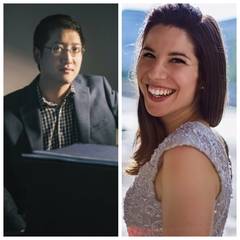|
Back
Daring Decalogue New York
Kaufman Music Center
03/16/2023 -
Győrgy Ligeti: Musica Ricercata No. 1
Christopher Cerrone: Passagework
Louis Couperin: Unmeansured Prelude in F
Anthony Cheung: Holding Patterns
Ludwig van Beethoven: Piano Sonatas No. 13 & No. 14, Opus 27, No. 1 & 2
Kaija Saariaho: Ballade
Johannes Brahms: Intermezzo, Opus 118, No. 4
Andrea Casarrubios: Sandglass
Robert Schumann: Fantasiestücke, Opus 12: 3. “Warum?”
David Kaplan (Pianist) 
D. Kaplan (© Courtesy of the artist)
“Piano: A utensil for subduing the impenitent visitor. It is operated by depressing the keys of the machine and the spirits of the audience.”
Ambrose Bierce
“I was fifteen years old, and I hardly knew how to play a simple Bach prelude on the piano when I began to compose music, and at the most advanced level. I had never studied such things as harmony.”
Győrgy Ligeti
No denying it. David Kaplan is not only an intelligent pianist, his adventurism in programing makes him a very rare artist. Assembling a decalogue of pieces from four centuries and four continents for two pianos, with hardly a break in between is...well, breathtaking.
But Mr. Kaplan, who’s been playing concertos since the age of nine, was hardly fazed. Not if last night at Kaufman Music Center was an example of a virtuosic pianism and almost insouciant personality. He explained the relationship of the heterogeneous music with the same fluidity as he played Beethoven’s Moonlight. He could turn around from a prepared piano to a Steinway in Anthony Cheung’s Holding Patterns without not so much as a hemidemiquaver pause.
And while the lack of applause between the works inevitably blurred the individuality of the works, the familiarity (Beethoven, Schumann, Brahms) offered a few landmarks during the foray.
Three of the composers had been commissioned by Mr. Kaplan, and they all paid heed to his liquid fingers. The last two times (here and here) I heard works by Mr. Cheung, I had been moderately impressed. With Holding Patterns, he wrote a three (or four)‑movement work which could have stunned a lesser artist. The music, though, like Scriabin on crack, never let go of its whirling inspiration, played with whirling nonchalance by Mr. Kaplan.

A. Cheung/A. Casarrubios (© Ben Gibo/Ravinia Festival)
Equally accomplished was Christopher Cerrone’s Passagework, written with wood‑cracking sounds on the prepared piano. Yet this was easily connected with the opening Ligeti Musica ricercata, a one‑note classic. The latter took a simple “A”‑note and rhythmically transposed it, keeping the same note until the very end, suddenly bringing it down to a simple “D”. (Shades of Boléro!)
Mr. Cerrone kept returning to another note, with a zigzag or gliding or off‑theme offerings at the keyboard. Like the other works on the program, one didn’t have to construe whatever serial or 12‑tone tune was behind the music. It was fun to hear, even more fun to hear Mr. Kaplan’s expertise.
The only “ancient” work was by Louis Couperin, who wrote (who knew?) preludes with no bar measures, with startling changes of time and harmonies. This all back four centuries ago! Mr. Kaplan sailed through it, his Steinway hardly a harpsichord, but with far ornamentation, one assumes, than the original.
The second half opened with a Ballade by the great Finnish composer Kaija Saariaho. Ms. Saariaho has composed for every conceivable (or inconceivable) ensemble, and her work, both mystical and magical, never fails to intrigue. I had never heard Ballade before, but even limited to a mere piano, a dense work, with a melody coming from the depths, transformed with sudden dynamics, returning to the depths rising again with changes of electric surprise.
In between some excellent performances of Brahms and Schumann, almost hidden in the tangled jungle of other notes, the cellist-composer Andrea Casarrubios wrote her commissioned Sandglass, itself a Romantic-style work which blended in with Mr. Kaplan’s own short Improvised Prelude.
Both halves of the program finished with one of the two Beethoven Op. 27 Sonatas. With another pianist, these could have been showpieces, works of familiarity to excuse us from the contemporary choices. Mr. Kaplan, yes, played the Prestos as fast as his finger would take him. In this case, the Beethoven merged quite nicely with the Presto inspirations of the other composers on this daring, offtimes delectable recital.
Harry Rolnick
|